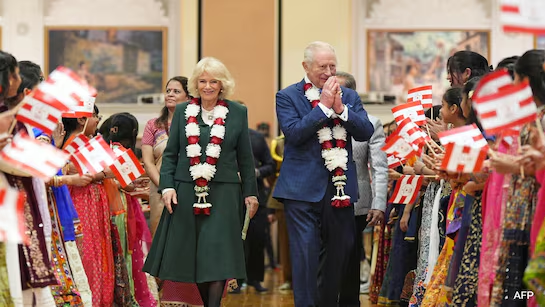Now Reading: King Charles III and Queen Camilla visit Europe’s first traditional Hindu stone temple in London
-
01
King Charles III and Queen Camilla visit Europe’s first traditional Hindu stone temple in London
King Charles III and Queen Camilla visit Europe’s first traditional Hindu stone temple in London

In a gesture of cultural appreciation, King Charles III and Queen Camilla visited the BAPS Shri Swaminarayan Mandir, Neasden in London — recognised as Europe’s first traditional Hindu stone temple. The visit marks its 30th anniversary and carries significance for Indian diaspora communities as well as observers in cities like Nagpur who follow global cultural-links closely.
The temple and the royal engagement
Located in Neasden, the Mandir opened in 1995 and was built following classical Vedic architectural principles. During the visit, the royal couple were welcomed with flower garlands and sacred threads, toured the intricately carved sanctum and engaged with members of the Hindu community. The presence of the monarch and queen brought renewed global attention to the temple’s contribution.
Cultural and diaspora significance
For the Indian community in the UK and abroad, such visits resonate deeply. They reflect recognition of India’s spiritual and architectural heritage on an international stage. For people in smaller Indian cities, this link between homeland culture and global platforms offers a sense of pride — illustrating that heritage built locally can have a global presence.
Implications for intercultural dialogue
Beyond symbolism, the visit underscores how cultural diplomacy operates today. It sends a message of respect between the British monarchy and the Hindu community, and highlights how faith, architecture and heritage can bridge national divides. For India and its citizens, it suggests that traditional culture remains relevant in fresh contexts — whether in London or in regional towns.
What locals in tier-2 cities can draw from this
Residents of towns like Nagpur or Jaipur may see this event as a reminder that culture and heritage have international value. Local artisans, heritage-builders and youth involved in traditional arts can view this as inspiration: your work can reach far beyond local boundaries. It also shows that modern visibility and global linkages do not diminish traditional values but can amplify them.
Conclusion
The royal visit to the Neasden Mandir is more than a photo opportunity — it’s a reflection of cultural convergence and global heritage consciousness. For Indians outside the metros, especially in smaller cities, it is a sign that identity, tradition and global presence need not be opposites. Culture built at home can be celebrated worldwide — if you give it the space and voice.
























